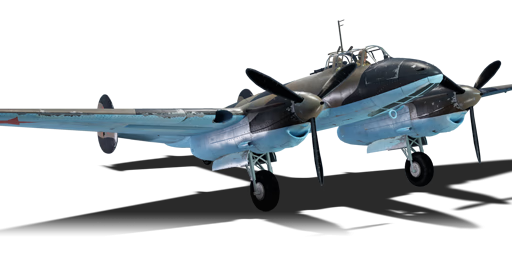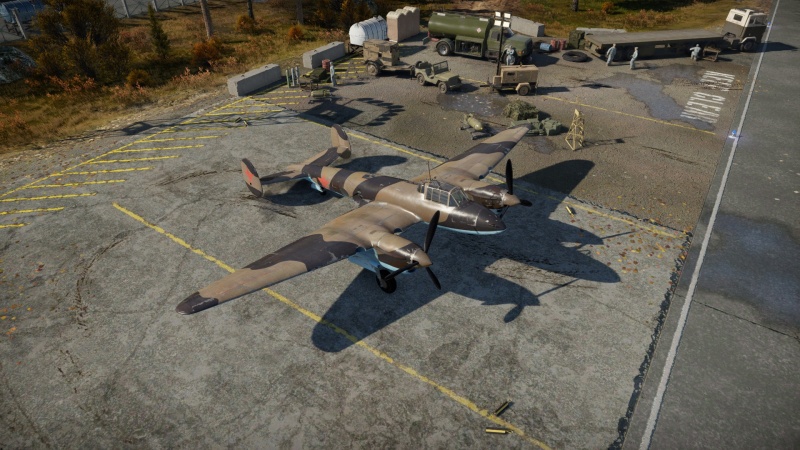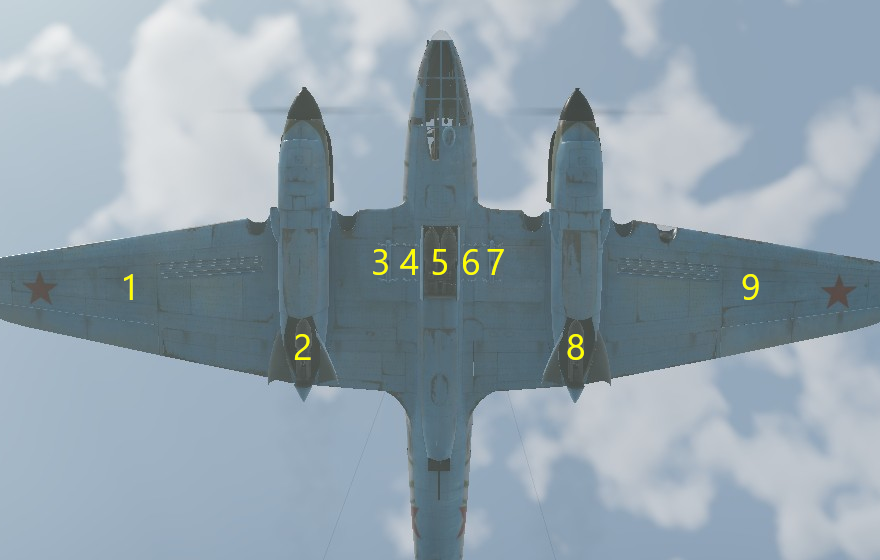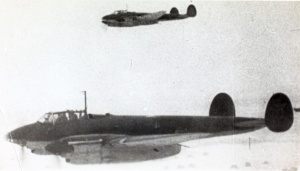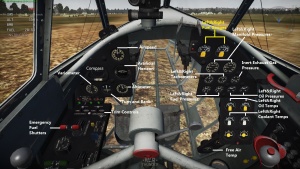Pe-2-110
| This page is about the Soviet frontline bomber Pe-2-110. For other versions, see Pe-2 (Family). |
Contents
Description
The Pe-2-110 Peshka is a rank III Soviet bomber with a battle rating of 4.0 (AB), 3.7 (RB), and 4.3 (SB). It has been in the game since the start of the Open Beta Test prior to Update 1.27.
The Pe-2 fulfils much the same attack aircraft role as the IL-2. While the guns are mostly .50 calibre and therefore worse than the IL-2's, it can carry much heavier bombs, allowing it to destroy targets in one hit that an IL-2 might take two or three bombs to destroy. Additionally, its nose-mounted weaponry and fact that it spawns at bomber altitude in most maps make it a surprisingly effective hit&run bomber. However, as in other attack craft, you should have a friendly cover you whenever possible. While it has defensive guns and is faster than the Sturmovik, it is still very vulnerable when caught alone. Additionally, it is very vulnerable to diving attacks due to its dorsal-mounted fuel tank. The inclusion of a 12.7 mm UB machine gun allows with a good aim to destroy tanks and light pillboxes, which can be very useful in certain situations.
The defensive armament on this plane is nothing spectacular and only allows for one to two guns to shot at an incoming airplane at a time. this will not stop most fighters without a lucky hit however it can discourage fighters from making slow approaches onto your tail. As such this plane should always be using its speed to its advantage.
General info
Flight performance
| Characteristics | Max Speed (km/h at 2,950 m) |
Max altitude (metres) |
Turn time (seconds) |
Rate of climb (metres/second) |
Take-off run (metres) | |||
|---|---|---|---|---|---|---|---|---|
| AB | RB | AB | RB | AB | RB | |||
| Stock | 464 | 449 | 8000 | 29.5 | 31.3 | 6.2 | 6.0 | 326 |
| Upgraded | 502 | 483 | 26.6 | 28.0 | 11.3 | 8.5 | ||
Details
| Features | ||||
|---|---|---|---|---|
| Combat flaps | Take-off flaps | Landing flaps | Air brakes | Arrestor gear |
| ✓ | ✓ | ✓ | ✓ | X |
| Limits | ||||||
|---|---|---|---|---|---|---|
| Wings (km/h) | Gear (km/h) | Flaps (km/h) | Max Static G | |||
| Combat | Take-off | Landing | + | - | ||
| 740 | 450 | 508 | 477 | 320 | ~11 | ~6 |
| Optimal velocities (km/h) | |||
|---|---|---|---|
| Ailerons | Rudder | Elevators | Radiator |
| < 380 | < 380 | < 440 | > 250 |
| Compressor (RB/SB) | ||
|---|---|---|
| Setting 1 | ||
| Optimal altitude | 100% Engine power | WEP Engine power |
| 2,000 m | 2,200 hp | 2,372 hp |
| Setting 2 | ||
| Optimal altitude | 100% Engine power | WEP Engine power |
| 4,000 m | 2,100 hp | 2,265 hp |
Survivability and armour
- 8 mm Steel plate behind the pilot x 2
- 8 mm Steel plate in behind of dorsal gunner
- 8 mm Steel plate in the ventral turret (bottom)
- 8 mm Steel plate in the ventral turret (top/rear)
- No armour glazing
- Critical components located in front of aircraft (fuel, pilot, engine, controls)
- More fuel tanks located in wings near fuselage
Modifications and economy
In the first rank, unlock DZ-40 first to get more bomb payload variants. Your speed and climb rate take a hit with the new heavier payloads, so focus on Flight performance modules. The remaining upgrades can be chosen and upgraded in any order.
Armaments
Offensive armament
The Pe-2-110 is armed with:
- 1 x 12.7 mm Berezin UB machine gun, nose-mounted (150 rpg)
- 1 x 7.62 mm ShKAS machine gun, nose-mounted (450 rpg)
Suspended armament
The Pe-2-110 can be outfitted with the following ordnance:
| 1 | 2 | 3 | 4 | 5 | 6 | 7 | 8 | 9 | ||
|---|---|---|---|---|---|---|---|---|---|---|
| 100 kg FAB-100M-43 bombs | 1 | 1 | 1 | 4 | 1 | 1 | 1 | |||
| 250 kg FAB-250M-43 bombs | 1 | 1 | 1 | 1 | ||||||
| 250 kg BRAB-250 bombs | 1 | 1 | 1 | 1 | ||||||
| 500 kg FAB-500M-43 bombs | 1 | 1 | ||||||||
| 500 kg BRAB-500 bombs | 1 | 1 | ||||||||
| M-13UK rockets | 5 | 5 | ||||||||
| RBS-132 rockets | 5 | 5 | ||||||||
| Maximum permissible loadout weight: 1,050 kg | ||||||||||
| Default weapon presets | |
|---|---|
| |
Defensive armament
The Pe-2-110 is defended by:
- 1 x 12.7 mm Berezin UB machine gun, dorsal turret (200 rpg)
- 1 x 12.7 mm Berezin UB machine gun, ventral turret (230 rpg)
- 1 x 7.62 mm ShKAS machine gun, 2 x beam turrets (225 rpg)
Usage in battles
The Pe-2-110 still lacks in defensive armament, with a rear-facing 12.7 mm being your main deterrent (the 7.62 mm side MGs don't offer much damage output or arc of fire). The front-facing armament still isn't impressive, but it's capable of strafing out open-top targets such as unaware SPAA or light vehicles such as the R3 T20 FA-HS, as well as being somewhat effective against fighters. Having allies about is still your best defence.
The Pe-2 is capable in Air RB as well as Ground RB due to its varied payload options. For air battles, any load will be effective (albeit the unlockable ones take a big toll on climb rate, acceleration and speed). The 6 x 100 kg option will still be a good choice for a quick and speedy mission. In ground battles, the 2 x 250 kg + 4 x 100 kg option and the 2 x 500 kg option are the best; it is recommended to use the 500 kg option if you are not as comfortable with bombs. These bombs do not drop in pairs. The -110 also has the option of carrying 10 x RS-132 or RBS-132 rockets on the wings. They are very difficult to aim, but can offer great results when used properly.
Manual Engine Control
| MEC elements | ||||||
|---|---|---|---|---|---|---|
| Mixer | Pitch | Radiator | Supercharger | Turbocharger | ||
| Oil | Water | Type | ||||
| Controllable | Controllable Not auto controlled |
Not controllable Not auto controlled |
Controllable Auto control available |
Separate | Controllable 2 gears |
Not controllable |
Pros and cons
Pros:
- Fast for a medium bomber
- High wing rip speed
- Near-infinite WEP (in RB)
- Has front facing armament
- Air start
- Utilizes bomb sight
- Can be used as a dive bomber to accurately destroy ground targets
- Gets bomber reload time (in AB)
Cons:
- Can not out run fighters
- Limited bomb payload options
- Weak defensive firepower
- Easily catches fire
History
Originally, the Petlyakov Pe-2 was not supposed to be a bomber at all. Its direct predecessor, designated VI-100, was designed by a prison design bureau team led by Vladimir Petlyakov as a high-altitude escort fighter. The VI-100 was very modern for its time, featuring a pressurized two-seat cockpit, electrically actuated systems and all-metal construction, and was powered by two supercharged Klimov M-105 V-12 inline engines producing 1,100 horsepower each. The prototype was completed in 1939 and during its first test flight on 7th May 1939, it reached a top speed of 627.6 km/h (390 mph) – an astounding performance for its time. The results of flight tests were so promising that the VI-100 was ordered into production.
However, Germany launched the "Blitzkrieg" campaign in September 1939. Aside from their revolutionary usage of tanks, the campaign in Poland featured notable usage of Ju 87 dive bombers and showed their potential. Consequently, the Soviet authorities ordered the VI-100 to be redesigned as a dive bomber. Pressurization equipment and engine superchargers were removed, dive brakes were installed under the wings and the bombardier position was added to the nose of the aircraft(raising the number of crew members to three). A ventral bomb bay was added along with the two smaller bomb positions located at the rear of engine nacelles. Two rear-facing turrets, each armed by a single ShKAS machine gun, were installed to dorsal and ventral positions. Resulting aircraft, able to carry up to 1,600 kg (3,520 lb) of bombs, was designated PB-100. The first prototype flew on 15th December 1940 and its performance (top speed of 540.7 km/h / 336 mph) was so good that Vladimir Petlyakov was released and the aircraft was named after him, thus receiving the designation Petlyakov Pe-2. The bomber was then rushed into serial production and deliveries to combat units began in the spring of 1941. The deliveries were, however, slow and by the time of the German invasion in June 1941, only about 458 Pe-2's were delivered.
The Pe-2, nicknamed Peshka ("Pawn") by its crews, quickly proved itself to be an effective dive bomber and together with the Ilyushin Il-2 Sturmovik attacker, it became the most important offensive weapon of the Soviet Army Air Force. The bomber was fast and agile enough to be an elusive target for German fighters and also proved its versatility – it was used for reconnaissance and artillery spotting and also became the basis for the Pe-3 heavy fighter. Losses were heavy, however. Crews often complained about a lack of armour protection for the cockpit and fuel tanks as well as poor defensive armament and unreliable dive brakes, which sometimes failed to retract and allowed top speeds of only around 300 km/h (186.4 mph), making the fast bomber easy prey.
| Archive of the in-game description | |
|---|---|
|
In June 1942, a new Toropov VUB-1 (a.k.a. B-270) upper turret mount began production. It began to be installed on all aircraft from series 110 onward. The VUB-1 was a shielded turret with a 200-round UBT machine gun and continuous belt feeding. The new turret provided considerably more comfortable working conditions for the crew than the primitive FT turret, which had left the cockpit virtually half-open. It was found that even physically strong gunners had difficulty turning the gun barrel at wide angles during flights. The new turret had an aerodynamic trim in the shape of two petals over the screen. Due to the aerodynamic trims of the VUB-1, the radio antenna mast had to be moved from the port side of the navigator's cockpit to the aircraft's central axial line. The VUB-1 turret was a significant improvement in the Pe-2's defensive capabilities. It is this variant that is quite often called the "Pe-2FT" by mistake, even though it has nothing to do with the FT turret. Aluminum deficiencies forced the designers to search for replacements for the Pe-2's all-metal assemblies. Beginning with series 115, some aircraft were manufactured with a wooden fuselage tail section and stabilizer. Due to a shortage of organic glass, the area of the cockpit's glazing was significantly reduced. First to disappear was the transparent patch at the front, then the small rectangular blisters on the top of the tail section; then the glazing on the side of the nose section was gradually narrowed. As a result, only a smooth glazing panel was left in the lower nose section. In early 1943, beginning with series 179, all production bombers obtained new high-powered 1,180 hp M-105PF engines with a lower critical altitude. Planes from earlier production series operating on the front lines were also equipped with M-105PF engines. A total of 2,392 Pe-2 aircraft were produced in 1942, which is more than four factories had produced a year earlier. This was partially due to the simplification of certain assemblies and removal of some equipment. Since the autumn of 1941, an RPK-2 radio compass and target finding device was installed on one plane out of three; from July 1942 on, a radio transmitter was mounted on every third plane; the rest had only receivers. | |
Media
- Skins
- Images
See also
- Related development
- Aircraft of comparable role, configuration and era
External links
| V.M. Petlyakov Design Bureau (Опытное конструкторское бюро Петлякова) | |
|---|---|
| Fighters | Pe-3 (e) · Pe-3 · Pe-3bis |
| Bombers | Pe-2-1 · Pe-2-31 · Pe-2-83 · Pe-2-110 · Pe-2-205 · Pe-2-359 · Pe-8 |
| USSR bombers | |
|---|---|
| SB and Ar | SB 2M-100 · SB 2M-103 · SB 2M-103 MV-3 · SB 2M-103U · SB 2M-103U MV-3 · SB 2M-105 · Ar-2 |
| Yer-2 (petrol) | Yer-2 (M-105) · Yer-2 (M-105) TAT · Yer-2 (M-105R) TAT · Yer-2 (M-105R) LU |
| Yer-2 (diesel) | Yer-2 (ACh-30B) (e) · Yer-2 (ACh-30B) (l) |
| Tu | Tu-2 · Tu-2S · Tu-2S-44 · Tu-2S-59 · Tu-4 |
| Pe | Pe-2-1 · Pe-2-31 · Pe-2-83 · Pe-2-110 · Pe-2-205 · Pe-2-359 · Pe-8 |
| IL | DB-3B · IL-4 |
| Po | Po-2 · Po-2M |
| Other | MBR-2-M-34 · TB-3M-17-32 · Yak-4 · Be-6 |
| Lend-Lease | ▂PBY-5A Catalina · ▂Hampden TB Mk I · ▂A-20G-30 · ▂B-25J-30 |


